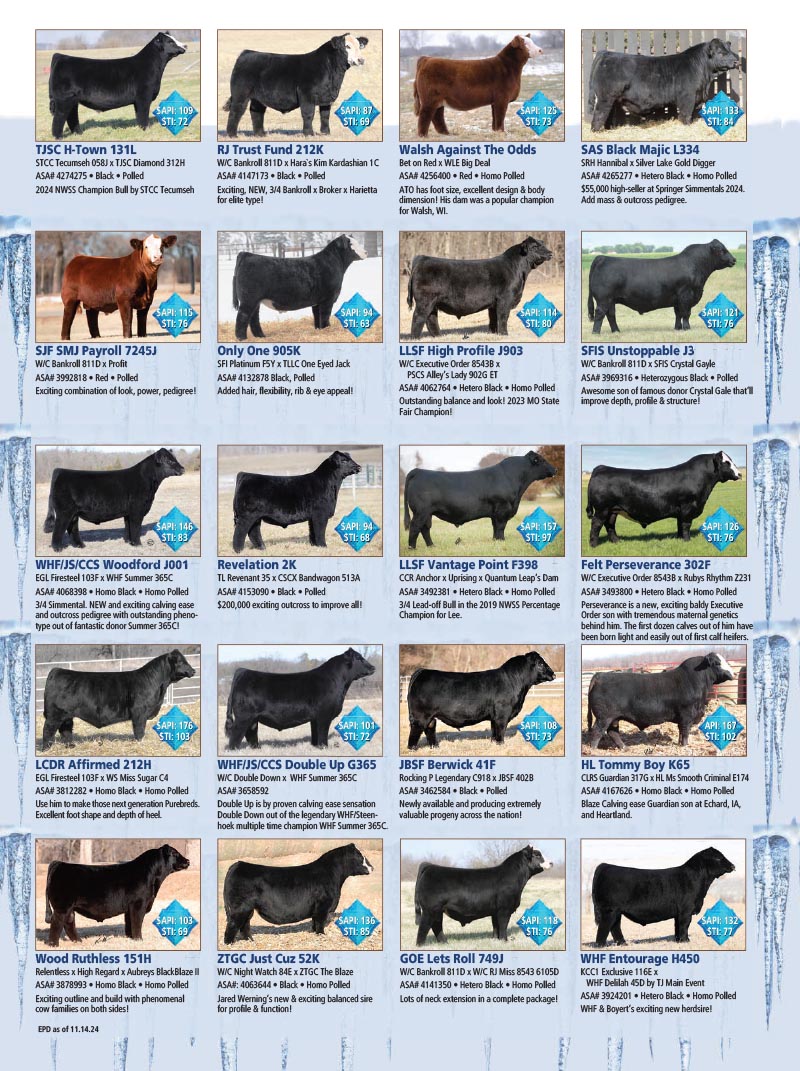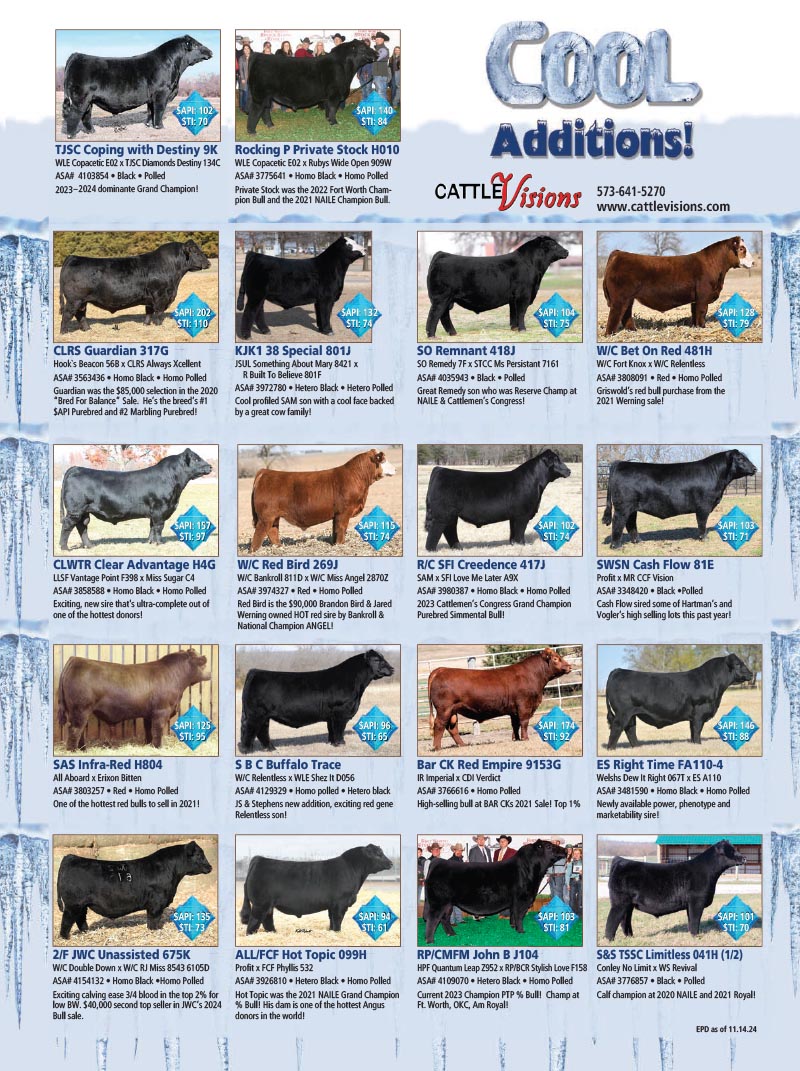by Dr. Jonathan DeClerck
Nutrition during critical stages of fetal development has an important impact on beef cattle performance throughout the production cycle.
As spring calves start hitting the ground, many ranchers are given a first glimpse of the results of their mating decisions. This exciting period often informs sire selection as producers strive to enhance the efficiency and marketability of their calf crops. However, bolstering calf performance via genetics is a continuous process that endures following the breeding season.
Recent developments in cattle research continue to underscore the importance of fetal programming, or the concept that lifetime performance of each calf is influenced by events prior to birth. The maternal environment provided for a fetus/calf is imperative and can lead to positive or negative outcomes. This notion is far from earth-shattering — for years human nutritionists and medical doctors have stressed the importance of fetal programming. No one would advise a pregnant woman to smoke, or consume harmful drugs, as it would provoke irreversible damage to their baby. But what about nutrition? Would you advocate for a pregnant woman to lose weight? If it’s not a good idea for pregnant women to lose weight, is it a good idea for pregnant cows?
The month of January saw the highest beef demand in 20 years alongside the smallest national cow herd in six decades. In response, packers have pushed for heavier hot carcass weights to meet market needs, resulting in larger mature cows with increased nutrient requirements.
These heightened nutritional demands put cows at greater risk for poor fetal programming outcomes. By understanding the critical role of maternal nutrition and management, seedstock producers can unlock the full potential of their cattle, optimizing efficiency, growth, reproduction, and longevity.
What Is Fetal Programming?
Fetal programming, also known as “developmental programming,” is the concept that environmental factors — such as maternal nutrition and stress — during critical stages of fetal development can have lasting effects on a calf’s health, productivity, and genetic expression. Originally introduced in human studies as the Barker Hypothesis, this idea suggests that prenatal conditions influence postnatal growth and adult function.
Research in both humans and livestock has shown that while an individual’s DNA sequence remains unchanged, the maternal environment can alter gene expression, ultimately shaping phenotype and lifetime performance. This underscores the importance of proper nutrition and management during pregnancy, as the choices made during gestation can significantly impact the genetic potential and future success of the offspring.

Lessons from History: The Dutch Famine and Epigenetics
A pivotal historical event during World War II highlighted the critical role of fetal nutrition. The Dutch Famine occurred when the German army blockaded the Netherlands for three months, severely restricting food supplies for approximately 4.5 million people. After the war, researchers studied women who had been pregnant during the famine to assess the long-term effects of fetal nutrient deprivation on their children.
The findings were striking. Children whose mothers experienced malnutrition during the first trimester had significantly higher rates of cardiovascular disease, high cholesterol, and obesity. Those exposed to famine during the second and third trimesters were more prone to diabetes, kidney disease, and asthma. This landmark study provided strong evidence for the concept of epigenetics — the idea that while genes themselves remain unchanged, environmental factors such as nutrition can influence their expression, leading to lasting effects on health and development.
This principle applies directly to cattle production. Even calves from the best cow families will have underwhelming phenotypes if they experience poor maternal nutrition or significant stress during gestation. Conversely, optimal maternal nutrition enhances the expression of desirable traits, ensuring the full realization of genetic potential.
Optimal maternal nutrition enhances the expression of desirable traits, ensuring the full realization of genetic potential
Key Factors Influencing Fetal Programming
Maternal Nutrition
The cow’s diet during pregnancy affects fetal muscle development, organ formation, immune function, and overall growth potential. Different stages of gestation influence specific aspects of fetal development:
First Trimester: Early pregnancy is when organ formation occurs. Proper nutrition ensures the developing fetus has the essential nutrients needed for optimal organ function. Importantly, ovarian reserves in heifers are established during this period, directly impacting future reproductive success. A 2013 study conducted in Ireland
by Francesca Mossa found that cows restricted to 60% of their nutritional requirements had heifer calves with lower ovarian reserves and higher blood testosterone levels, making them less fertile. This can impact embryo transfer programs, as females with lower ovarian reserves typically have a poor response to superovulation.
Second Trimester: The primary development of muscle fibers occurs during this stage, which is the precursor to future performance and phenotypic muscle expression. If the dam is underfed, the calf may develop fewer muscle fibers, potentially reducing growth and carcass merit. A 2010 study by Keith Underwood at the University of Wyoming compared pregnant cows on native pasture (6.0% crude protein) versus improved pasture (11.1% crude protein). Calves born from cows grazing the improved pasture weighed 31 pounds more at weaning and 48 pounds more at harvest, demonstrating the direct impact of maternal nutrition on growth potential.
Quality nutrition, from hay to mineral supplementation, requires careful planning and execution. Photo by Kendon McAlister.

Considering that the number of muscle fibers are established prior to birth, pregnant cow nutrition is imperative to all cattle producers. Commercial cow-calf operators are paid by the pound, and total muscle mass drives weight. Conversely, seedstock bull producers typically receive a premium for phenotypically heavy muscled, higher performing cattle.
Third Trimester: This period is critical, as it accounts for 75% of fetal growth and has significant implications for respiratory disease (BRD), which costs the cattle industry over $1 billion annually in morbidity, mortality, and lost performance. The third trimester is also when fat deposits develop, influencing energy metabolism and future reproductive success. A series of studies from the University of Nebraska (Stalker et al., 2006, 2007; Larson et al., 2009) examined the impact of protein supplementation during late gestation on offspring performance. Results showed that calves from supplemented dams had a lower incidence of respiratory disease at weaning. Steers from these dams exhibited heavier carcass weights and a higher percentage of carcasses grading Choice and Premium Choice. Additionally, heifers from protein-supplemented dams had significantly higher pregnancy rates and calved earlier than those from non-supplemented cows.
Stress and Environmental Factors
In addition to nutrition, environmental stressors such as extreme weather, disease, or inadequate handling can also impact fetal development. High stress levels in pregnant cows can lead to increased cortisol levels, which may negatively affect the calf’s immune function, and future reproductive success.
During droughts, producers typically cull cows to align herd size with limited forage availability. Once pastures recover with sufficient rainfall, herds are rebuilt by retaining a higher percentage of heifers. However, heifers that were in utero during drought-induced nutrient restriction and stress are more likely to face breeding challenges. In my experience as a nutritional consultant, this trend was evident in Texas cattle that were in utero during the 2011 and 2013 droughts, highlighting the long-term impact of environmental stress on reproductive efficiency.
Practical Application for Breeders
With an industry demanding superior genetics, fetal programming is an essential piece of the puzzle. Implementing fetal programming strategies doesn’t require a complete overhaul of management practices, but it does involve attention to detail in key areas:
Producers have many decisions to make when it comes to cow herd nutrition. A nutritionist can provide valuable guidance. Photo by Susan Russell.

The third trimester of pregnancy is critical, as it accounts for 75% of fetal growth. Photo by Halee Allen.
Nutritional Planning
Work with a nutritionist to ensure gestating cows receive adequate protein, energy, vitamins, and minerals. Adjust rations based on forage availability and seasonal conditions. The objective is to ensure that cows “never have a bad day” and consistently receive the nutrients they need to support both their own requirements and the optimal development of their growing fetuses.
Monitoring Body Condition
Maintain cows at appropriate body condition scores (BCS 5–6) to ensure adequate levels of nutrition. Be proactive: BCS lags 4–6 weeks, so a decline indicates prior nutrient level deprivation, which could have already harmed fetal development.
Reducing Stress
Utilize low-stress handling, provide adequate shade and windbreaks to protect against harsh weather, minimize transportation during late pregnancy, and ensure optimal herd health through timely vaccinations and parasite control.
Final Thoughts
Fetal programming provides a science-based strategy for enhancing the genetic potential of seedstock cattle. The Simmental breed has a strong tradition of adopting technology and best practices to meet the evolving needs of the cattle industry. With elevated beef demand driving mature cow weights to record highs, the risk of compromised fetal programming outcomes is higher than ever. By focusing on proper nutrition, stress reduction, and sound management during gestation, breeders can further strengthen Simmental’s reputation for innovation — producing cattle that excel in performance, efficiency, and longevity. As the cattle business continues to progress, leveraging fetal programming principles will be key for staying ahead of the competition and delivering genetics that drive profitability for generations to come.

Dr. Jon DeClerck is ASA’s incoming Executive Vice President and will begin in the role on July 1, 2025, following Dr. Wade Shafer’s official retirement. DeClerck worked as a Technical Consultant for Purina Animal Nutrition, and has advised stakeholders across the beef production cycle in New Mexico, Texas, and Louisiana, combining innovative research with practical solutions to help producers maximize profitability. Previously, he served as a lecturer and livestock judging coach at Texas Tech and Iowa State University, mentoring students and leading multiple national champion livestock and meat evaluation teams. DeClerck has been recognized as a national champion team coach, and is the recipient of numerous industry awards. Raised on a diversified farm near Aledo, Illinois, featuring a Simmental and commercial cow herd, Dr. DeClerck has a deep connection to the breed.



